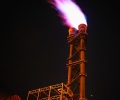U.S. natural gas adds to prior session’s huge gain on frigid weather

U.S. natural gas futures rose almost 12% on Friday on forecasts for much colder weather and higher heating demand in the next two weeks than previously expected, which also caused prices in the now-expired February contract to soar by as much as 70% on Thursday.
In the last half hour of trading on Thursday, futures for February soared in a late flurry of buying that coincided with the imminent expiration of the contract at the end of the session.
Traders said short-covering after a larger-than-usual weekly storage draw and forecasts for colder-than-normal weather were the primary reasons for Thursday’s late-day price spike.
On its first day as the front-month, gas futures NGc1 for March delivery were up 50.5 cents, or 11.8%, to $4.788 per million British thermal units (mmBtu) at 9:10 a.m. EST (1410 GMT).
But compared to where the February contract closed when it was the front-month on Thursday, the March contract was down about 24%, which would be the biggest daily percentage decline since December 1995 when it hit a record 31%.
In intraday trade on Thursday, the February contract rose to $7.346 per mmBtu, the highest price for the front-month since November 2008. The contract settled up about 46% at $6.265, its biggest daily percentage gain on record and the highest close for the front-month since October 2021.
For the week, the front-month was on track to rise about 21% in its biggest weekly percentage gain since August 2020, after falling about 6% in the prior week.
In the spot market, frigid weather and high heating demand over the past week or so in the U.S. Northeast have kept next-day power and gas prices in New York and New England at or near their highest levels since January 2018.
Analysts forecast the extreme cold would force utilities to keep pulling massive amounts of gas from storage in coming weeks, causing total inventories to fall over 10% below average for this time of year.
In addition to extreme cold, record U.S. liquefied natural gas (LNG) exports were also supporting prices as global LNG buyers look for ways to send more fuel to Western Europe in case Russia invades Ukraine and cuts off gas supplies to the rest of the continent.
Output, meanwhile, remained slow to return from freezes earlier in January.
Data provider Refinitiv said average output in the U.S. Lower 48 states fell from a record 97.6 billion cubic feet per day (bcfd) in December to 94.2 bcfd so far in January after wells in several regions froze, including the Permian in Texas and New Mexico, the Bakken in North Dakota and Appalachia in Pennsylvania, West Virginia and Ohio.
Refinitiv projected average U.S. gas demand, including exports, would drop from 144.2 bcfd this week to 133.9 bcfd as the weather turns less cold before jumping to 140.6 bcfd in two weeks when the weather turns frigid again.
On a daily basis, Refinitiv projected demand plus exports would jump to 156.5 bcfd on Feb. 4, the expected coldest day of the year across much of the country, which would top the current record of 155.8 bcfd on Jan. 21.
The amount of gas flowing to U.S. LNG export plants has averaged 12.5 bcfd so far this month, which would top December’s monthly record of 12.2 bcfd.
Source: Reuters (Reporting by Scott DiSavino Editing by Paul Simao)

 Hellenic Shipping News Worldwide Hellenic Shipping News Worldwide, Online Daily Newspaper on Hellenic and International Shipping
Hellenic Shipping News Worldwide Hellenic Shipping News Worldwide, Online Daily Newspaper on Hellenic and International Shipping






















 PG-Software
PG-Software